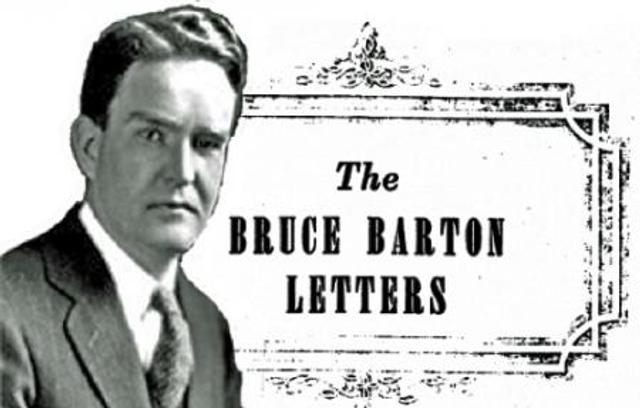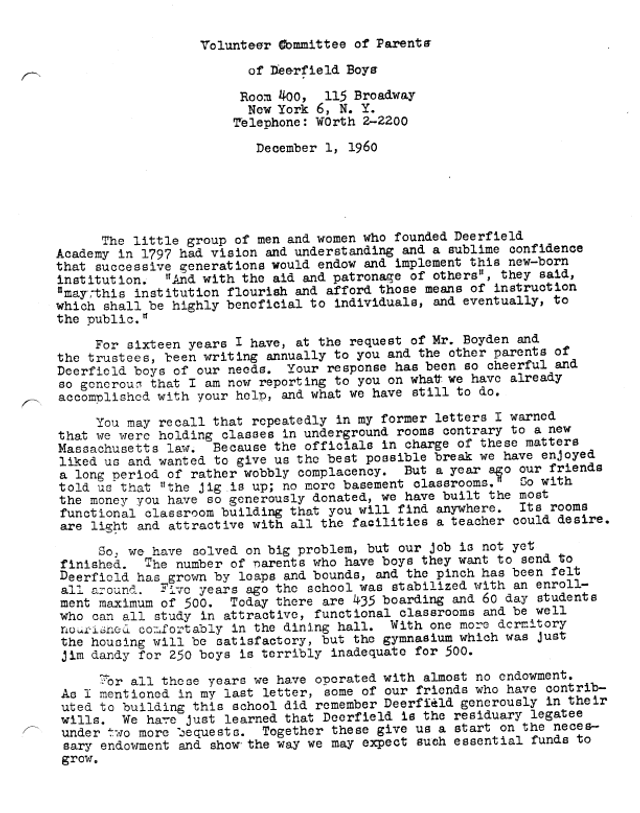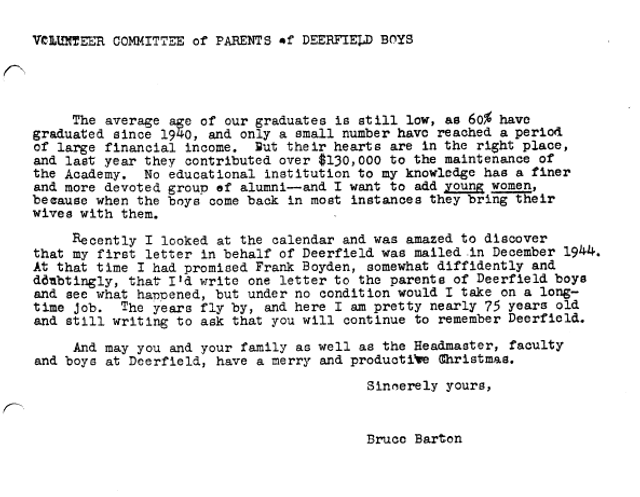Deerfield Academy: Bruce Barton’s fundraising letters from 1960, letter 22
- Exhibited by
- SOFII
- Added
- July 18, 2011
- Medium of Communication
- Direct mail.
- Target Audience
- Individuals.
- Type of Charity
- Children, youth and family.
- Country of Origin
- USA.
- Date of first appearance
- December, 1960.
SOFII’s view
Sixteen years have passed since Bruce Barton penned his first fundraising letter for Deerfield Academy, his old school, he’s 75 years old now and this is his last. But he can look back at a formidable fundraising achievement and say, ‘job done and then some’. He could also, had he foreseen it, take pride in the remarkable lesson in fundraising fine writing and effectiveness that he has left to posterity and to us.
Creator / originator
Bruce Barton.
Summary / objectives
Bruce Barton’s objective is always the same. With as small an outlay in energy and expenditure as is practical and possible he sets out to nurture and keep close a substantial group of key friends and generous donors, the parents of pupils at this special school, a group united by their desire to keep the old school great. Barton, backed by the trustees and headmaster Boyden, knows he can safely bank on this small band of loyal donors to provide the money needed to equip the school for its important task, whatever needs arise.
Background
Letter 22 is a fine example of legacy fundraising. It’s late 1960. The writer, a former giant of advertising and one of the original Madmen (though perhaps distinguished by his possession of morals, scruples and high ideals) is now long retired. Yet, even to his own surprise, he’s still fundraising. And still writing pithy and well-turned phrases that appeal to the direct mail fundraiser’s heart as well as to donors, such as, ‘…the gymnasium, which was just jim dandy for 250 boys is terribly inadequate for 500’.
Lovely. But not for much longer.
This last letter hints also at that beautiful if often unappreciated advantage of fundraising for an academic institution. Future income is built in to the system when the number of alumni is growing and these young folk go out into the world themselves and start to achieve what Barton calls ‘a period of large financial income’. This takes time to come through, of course, and requires careful nurturing before some of it shows up in alumni donations. But as Barton suggests, if ‘their hearts are in the right place’, future needs will be easily taken care of.
Perhaps this explains why these fundraising letters stop when they do. Or maybe their writer got to be just too darned old.
Things are changing. On page two Barton underlines that he ‘wants to add young women’. Not as students though, not yet. Women still only figure as wives of alumni (Deerfield Academy went co-ed in 1989).
The years fly by, as Barton remarks, and it is comforting to see that his effective fundraising has provided for every need of the school through the long period covered by these letters. If there were further needs, for sure it would have gone on doing so into the future, long after Bruce Barton, Frank Boyden and their colleagues had ceased to be involved.
It’s been a pleasure to share their journey.
Merits
Simply, because they are brilliant.
Other relevant information
That’s it. No more Bruce Barton Deerfield letters. At least, not until you or one of SOFII’s other readers unearths as yet undiscovered examples of early fundraising from the master copywriter.
But do click the links opposite. Bruce Barton really is worth re-reading, and revisiting often.



















